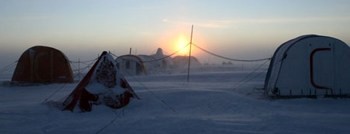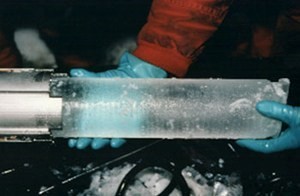Climate Illuminated

CO2 Lags Temp in Antarctica

Anthony WattsJuly 23, 2012 /
The question of “which comes first, the temperature or the CO2 rise?” has been much like the proverbial “which came first, the chicken or the egg?” question. This seems to settle it – temperature came first, followed by an increase in CO2 outgassing from the ocean surrounding Antarctica.
“Our analyses of ice cores from the ice sheet in Antarctica shows that the concentration of CO2 in the atmosphere follows the rise in Antarctic temperatures very closely and is staggered by a few hundred years at most,” – Sune Olander Rasmussen

Fig. 2. Lag histograms for the two methods of determining the lag of atmospheric CO2 after regional Antarctic temperature changes (direct correlation and correlation of derivatives), using each of the two CO2 data sets (Byrd and Siple Dome). The gray background histograms are based on the complete Tproxy composite, the same as in Fig. 1b. The superimposed curves show the corresponding lag histograms when excluding in turn each of the 5 records from the Tproxy composite (jack-knifing): excluding Siple (red), excluding Law Dome (green), excluding Byrd (blue), excluding EDML (cyan), and excluding Talos Dome (magenta).
From the University of Copenhagen – Rise in temperatures and CO2 follow each other closely in climate change
The greatest climate change the world has seen in the last 100,000 years was the transition from the ice age to the warm interglacial period. New research from the Niels Bohr Institute at the University of Copenhagen indicates that, contrary to previous opinion, the rise in temperature and the rise in the atmospheric CO2 follow each other closely in terms of time. The results have been published in the scientific journal, Climate of the Past.

The Australian ice core drilling camp at Law Dome in Antarctica.
In the warmer climate the atmospheric content of CO2 is naturally higher. The gas CO2 (carbon dioxide) is a green-house gas that absorbs heat radiation from the Earth and thus keeps the Earth warm. In the shift between ice ages and interglacial periods the atmospheric content of CO2 helps to intensify the natural climate variations.
It had previously been thought that as the temperature began to rise at the end of the ice age approximately 19,000 years ago, an increase in the amount of CO2 in the atmosphere followed with a delay of up to 1,000 years.
“Our analyses of ice cores from the ice sheet in Antarctica shows that the concentration of CO2 in the atmosphere follows the rise in Antarctic temperatures very closely and is staggered by a few hundred years at most,” explains Sune Olander Rasmussen, Associate Professor and centre coordinator at the Centre for Ice and Climate at the Niels Bohr Institute at the University of Copenhagen.

An ice core from the deep drilling through the ice sheet at Law Dome in Antarctica.
The research, which was carried out in collaboration with researchers from the University of Tasmania in Australia, is based on measurements of ice cores from five boreholes through the ice sheet in Antarctica. The ice sheet is formed by snow that doesn’t melt, but remains year after year and is gradually compressed into kilometers thick ice. During the compression, air is trapped between the snowflakes and as a result the ice contains tiny samples of ancient atmospheres. The composition of the ice also shows what the temperature was when the snow fell, so the ice is an archive of past climate and atmospheric composition.
“The ice cores show a nearly synchronous relationship between the temperature in Antarctica and the atmospheric content of CO2, and this suggests that it is the processes in the deep-sea around Antarctica that play an important role in the CO2 increase,” explains Sune Olander Rasmussen.

Figure 1 – The research results show that the concentration of CO2 in the atmosphere followed the temperature in Antarctica closely throughout the shift from ice age to interglacial in the period 19-11,000 years before the present.
The green curve shows the temperature from measurements from the 5 ice cores marked on the map. The red and blue curves show the atmospheric CO2 content in the air bubbles in the ice cores from the two bores at Siple Dome (red) and Byrd (blue). The analysis shows that the CO2 concentration follows the increase in temperature with a delay of no more than a few hundred years. That the CO2 concentration in the atmosphere follows the Antarctic temperature so closely suggests that processes in the ocean around Antarctica play an important role in the rise in CO2.
He explains that one of the theories is that when Antarctica warms up, there will be stronger winds over the Southern Ocean and the winds pump more water up from the deep bottom layers in the ocean where there is a high content of CO2 from all of the small organisms that die and fall down to the sea floor and rot. When strong winds blow over the Southern Ocean, the ocean circulation brings more of the CO2-rich bottom water up to the surface and a portion of this CO2 is released into the atmosphere. This process links temperature and CO2 together and the new results suggest that the linking is closer and happens faster than previously believed.
The global temperature changed naturally because of the changing solar radiation caused by variations in the Earth’s orbit around the Sun, the Earth’s tilt and the orientation of the Earth’s axis. These are called the Milankowitch cycles and occur in periods of approximately 100,000, 42,000, and 22,000 years. These are the cycles that cause the Earth’s climate to shift between long ice ages of approximately 100,000 years and warm interglacial periods, typically 10,000 – 15,000 years. The natural warming of the climate was intensified by the increased amount of CO2 in the atmosphere.
“What we are observing in the present day is the mankind has caused the CO2 content in the atmosphere to rise as much in just 150 years as it rose over 8,000 years during the transition from the last ice age to the current interglacial period and that can bring the Earth’s climate out of balance,” explains Sune Olander Rasmussen adding “That is why it is even more important that we have a good grip on which processes caused the climate of the past to change, because the same processes may operate in addition to the anthropogenic changes we see today. In this way the climate of the past helps us to understand how the various parts of the climate systems interact and what we can expect in the future.”
The article in the Climate of the Past
Tightened constraints on the time-lag between Antarctic temperature and CO2 during the last deglaciation
J. B. Pedro1,2, S. O. Rasmussen3, and T. D. van Ommen2,4 1Antarctic Climate & Ecosystems Cooperative Research Centre, University of Tasmania, Hobart, Tasmania, Australia 2Institute of Marine and Antarctic Studies, University of Tasmania, Hobart, Tasmania, Australia 3Centre for Ice and Climate, University of Copenhagen, Copenhagen, Denmark 4Australian Antarctic Division, Kingston, Tasmania, Australia
Abstract. Antarctic ice cores provide clear evidence of a close coupling between variations in Antarctic temperature and the atmospheric concentration of CO2 during the glacial/interglacial cycles of at least the past 800-thousand years. Precise information on the relative timing of the temperature and CO2 changes can assist in refining our understanding of the physical processes involved in this coupling. Here, we focus on the last deglaciation, 19 000 to 11 000 yr before present, during which CO2 concentrations increased by ~80 parts per million by volume and Antarctic temperature increased by ~10 °C. Utilising a recently developed proxy for regional Antarctic temperature, derived from five near-coastal ice cores and two ice core CO2 records with high dating precision, we show that the increase in CO2 likely lagged the increase in regional Antarctic temperature by less than 400 yr and that even a short lead of CO2 over temperature cannot be excluded. This result, consistent for both CO2 records, implies a faster coupling between temperature and CO2 than previous estimates, which had permitted up to millennial-scale lags.
Final Revised Paper (PDF, 463 KB) Discussion Paper (CPD)
Citation: Pedro, J. B., Rasmussen, S. O., and van Ommen, T. D.: Tightened constraints on the time-lag between Antarctic temperature and CO2 during the last deglaciation, Clim. Past, 8, 1213-1221, doi:10.5194/cp-8-1213-2012, 2012.
We should revisit occasionally what the proper role of government is. As the constitution was a good sense of direction, we need a core set of principles to add in order to deal with the future.
So many want to engineer society, remove risk, assist certain groups, rather than let individuals thrive and raise communities. Why?
Is Democracy where we all "get it good and hard" or is it the best means to a free society?
Should we roll with the special interests, or make the government achieve its proper role, what is that role, and how to do this?
When do deficits and governments become too large?
Government is becoming more elitist while trying to sell corrections to problems it created, what makes this possible?
This could also be inserted into the field above, or erased
Currently as a society, we are having a most difficult time discussing political issues. What is driving this? And why a rebirth in political culture would be a good thing.
Are "markets" dead as some would conjecture? Or is free enterprise what got us here?
At the heart of economics there are several possible economic schools of thought, the essence of these schools of thought and how they relate to our lives.